Published on 4/23/2015
So now we get to our first proper road trip in this car. To date we've mainly meandered around the greater Cape Peninsula, and out into the Overberg and surrounds once or twice. This trip was different. It was going to be more than two thousand kilometres in total.
We were going up for a wedding, and had decided to make a two week holiday out of it. There were several friends going as well, all on different routes and times and we would meet up in Windhoek. But how do you pack two peoples' two weeks worth of luggage into an MX-5? You don't, you use a boot-rack instead. I had borrowed one from a fellow club member. But clothing and toiletries was just the start. There is one thing about the NA MX-5 that no engineer can get around - the size of the wheels. They don't fit in the boot. The car comes with a minispare (or as we call it, a Marie-biscuit), which is fine. But what do you do with the proper wheel then if you have a passenger? So I opted for a bunch of rescue gear instead, and threw out the spare completely. This included a heavy-duty off-road type compressor (the sort that hooks up directly to the battery instead of plugging into the cigarette lighter), lots of tyre-plugs and also tyre-goop. I was fairly determined not to be stranded in the middle of nowhere.

I decided to take the straight and boring route - the N7. Now, the problem with any of the national routes in South Africa is the cargo hauls. Since the demise of the railways, these routes have become the main arteries of the cargo business. The N7 trails along the west coast where port jackson bushes and wheat farmland is exchanged for fruit trees and mountainous greenery as you pass over the Piekenierskloof pass. This is a narrow and terrible pass. There's been road works on it for as long as I can remember, and there are almost no overtaking areas to get past the slow, thundering and black exhaust-spewing lorries as they try to get over this mountainous area. Four years later and I have yet to cross it again; hopefully it's better now.
I must state that this car is simply epic on the long road. Sure, it's engine isn't a creamy V6 and the gearbox isn't a smooth and hassle-free auto, but the car is solid on the road and you get tremendous control through the quick steering rack. All of this sounds counter-intuitive, but compare this to something like a simple Ford Figo for instance (a much more modern car) which rolls around in a cross wind, pitches and dips over any sort of bump and has vague steering which requires constant flailing to ensure you go straight on any sort of road camber. It's truly tiresome to drive something like the Figo for an extended amount of time. The MX-5 though, not so.
Soon the valley of fruits and honey are given up as you pass Vanrhynsdorp. The end of the Karoo plateau is also on your right now, and the arid climate starts to take over here. Small, grey shrubs dot the landscape, and it's hot. The little car was simply stellar, the engine was singing and the wind rushing past. We had the roof up for the most part from the sun, but the air conditioning in our car had long ago puffed the last of its gas. The one thing that made up for that is the seats. They are supreme and my wife falls asleep in them in five minutes flat. And so we pulled up in Garies for a loo break. We had driven for the most part of the day, almost 530 kilometres.
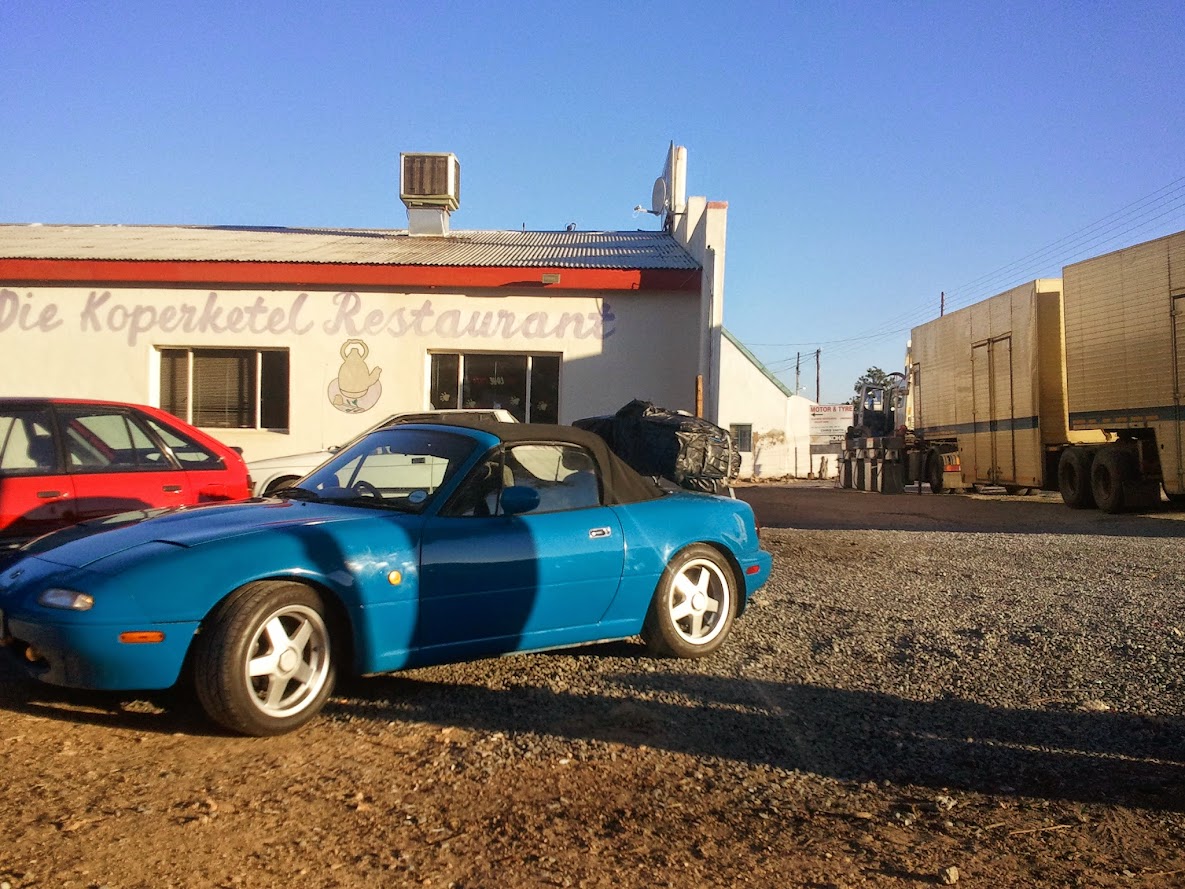
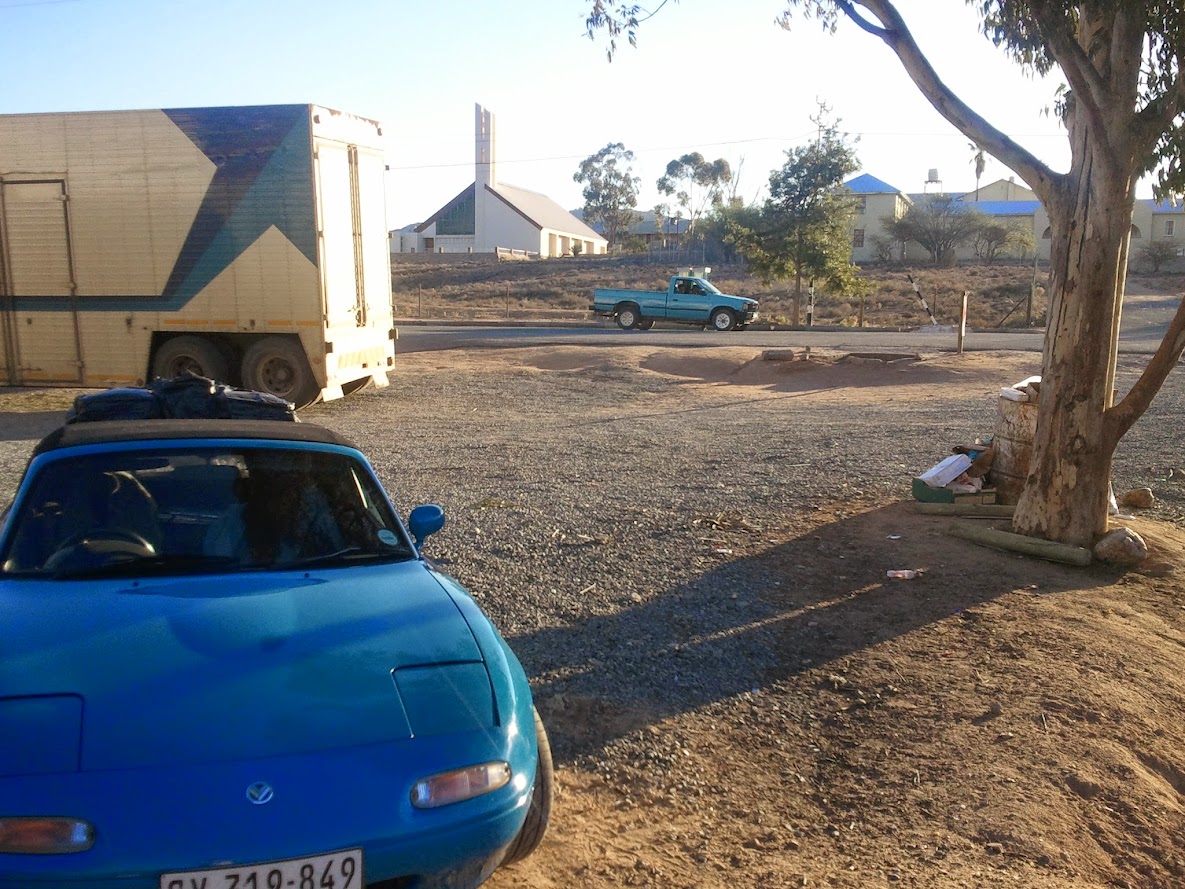
I wanted to reach Springbok before night-fall - another 120 kilometres. So we got back into the car and... nothing. It was dead. It wouldn't turn over, although all the other electrics were working. I poked around a bit, but there wasn't anything I could do without tools really. We decided to spend the night at the B&B right next to the fuel station. It was solemn, and my wife tried to console me. The beer helped a bit too. In the morning, a cat had urinated on the soft top, and I got hold of the owner of the fuel station (and the B&B). He had a workshop at the back. As it turned out, he was a former employee at a BMW service centre somewhere in the city, and had retired here and was applying his trade in the old-fashioned way. Meaning he actually fixed stuff instead of simply replacing parts. And of course, I wasn't his only customer that morning. In a small town, on the edge of the greatest plain in South Africa, this guy was having a Thursday morning to beat any other while we were having breakfast in his restaurant.
He had the fuel-pump out to see if that had given up, but ultimately he found that the main relay had popped. This was an 'a-ha' moment for me. I had completely forgotten about that first breakdown, and had driven the car constantly since then for almost two years, so this did come as a surprise. To get under way he helped me make up a by-pass for the relay using a 10 Amp fuse. Ultimately I found it rather humorous, this make-shift fix for what had turned out to be this make-shift car.
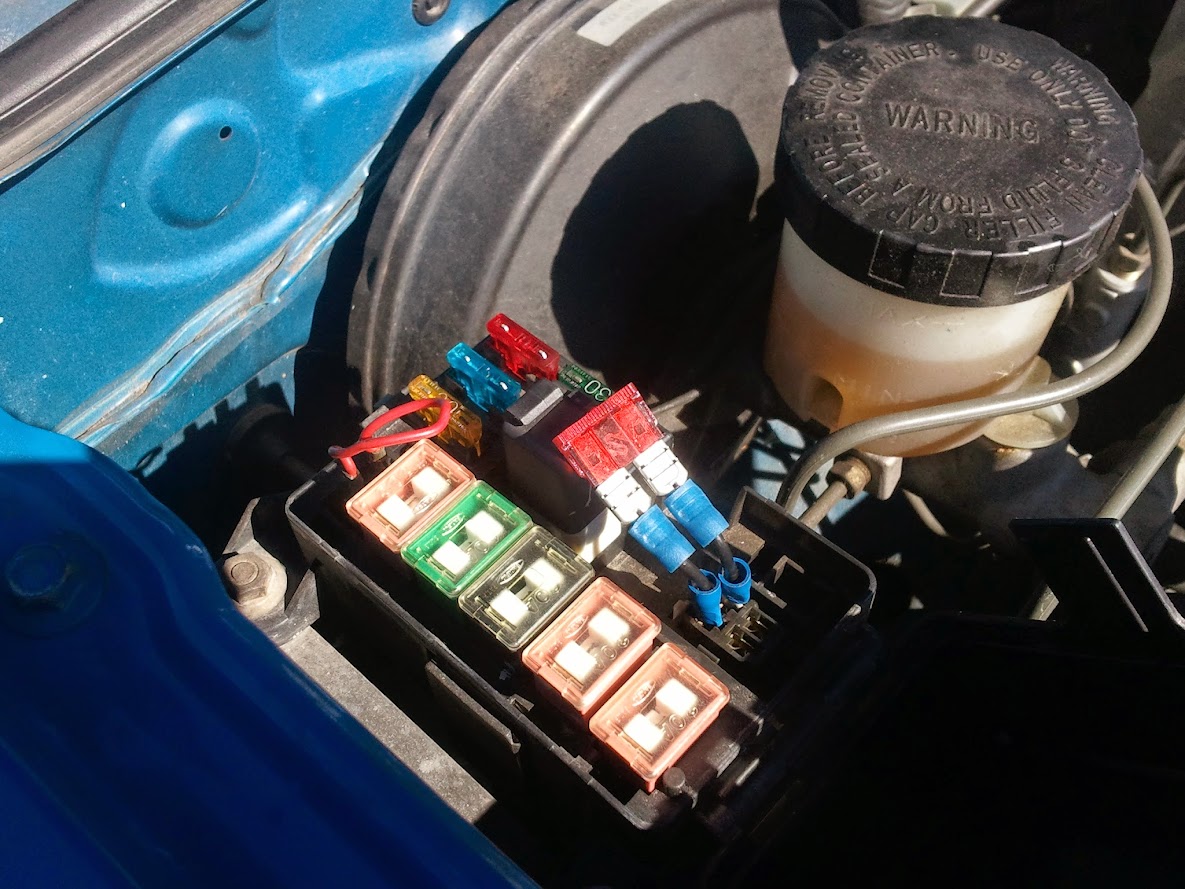
At Springbok I tried to shop for a new relay, but to no avail, and we just set off for the border with Namibia where we arrived late afternoon. Here, things almost went awry. I suspect that the South African police officer saw the history of the car on his computer, that it had been imported from Malawi. This he figured gave him an ideal opportunity, since he immediately stated that the car had been reported stolen in Malawi. Of course, I'm not a regular border-crosser, so this came as huge surprise to me (and I only realised later he was surely looking for a bribe). I was on the phone to my colleague from who's in-laws I bought the car, but fortunately I had all the paper work and clearances for the new engine and everything with me, to which this warrant-officer William surrendered his claim and simply said "It's fine". We were stamped and through the Namibian side in less than 15 minutes. We spent the night at the Orange River Lodge on the Namibian side.
The next morning we set off for... Ai-Ais. My wife insisted that we should go there, so I turned onto the C-grade gravel road and set off into the reserve. The wash-board roads were terrible, and it shook us to pieces as we went down into the fish river valley. After a while I even stopped caring about the car as we burst out laughing for the insane situation we had put ourselves in. Here we were in probably one of the most unsuitable cars for this trip, on a gravel road in the middle of a reserve, getting our teeth rattled from their sockets. So when we reached the resort, we weren't at all surprised to have to park between Land Rovers, Cruisers, Fortuners and all manner of off-road trailers attached to each one.
We got a plethora of comments from the other 'hard-core' resort visitors in their massive pick ups, mostly the "What the fuck!?" sort. Still, we enjoyed the resort as day visitors. It was rather tranquil, my wife went for a swim in the various pools and hot springs, and we had some drinks. Then it was off again. She wanted to see the Fish-river canyon, we needed to reach Keetmanshoop before nightfall, and I actually had no idea how long or far we were from either. From here the roads became much worse. There had been a massive storm earlier in the week, and it was supposedly still raining in the northern parts of the country. The gravel roads showed the extent of the flash floods and rivers. In general, C-grade roads in Namibia is the equivalent of 80 to 120 km/h tar roads, but not on this occasion. Huge swaths of veld had been taken by the rains and been run over the road, causing muddy or sandy pits, or massive rock-hard settled sand lumps, spanning the entire width of the road. Since the car is low, and rear-wheel drive, I was scared of getting stuck, and no amount of rescue gear would allow me to get us out again on my own. So, unless I was pretty sure it wasn't the rock-hard sand lumps, I simply floored it, relying on momentum to carry us through the longer stretches of mud or sand. It was truly hair raising, and at one point I basically sand-boarded the car across one of these pits, flat on it's engine-cover belly and chassis. Sand went everywhere, and later I wiped some off the top of the engine, from between the cams.
The C-grade road became so bad that I thought we were driving on a bed of rocks instead. But, soon we had to turn off from this onto a D-grade road to get to the Fish-river canyon lookout point. This road forced me down to 20 or 30 km/h. We didn't time it, but I reckoned it took us almost 2 hours to do the in and out legs of this 15 kilometre stretch. I was in a pretty foul mood by now. The car was suffering badly, those fancy new Koni sport dampers were getting hammered, the engine and gearbox mountings were getting hammered, and it was hot. It was really hot and dusty. Our visit to the lookout point was, in a word, disappointing. The lookout point itself was unstaffed and there were no refreshments available in a tuck shop or otherwise. The view though... that was spectacular. The depth and width of the canyon is on a scale that neither I nor a photograph can convey. This is definitely a place that I would want to visit again, and would want to hike as well.
After we made our way out from the lookout, we turned north again and hoped to stumble across some civilisation. By now I had done 250km since the border, which on a smooth tar road would be almost half a tank. On these roads, however, with all the braking and slowing down it wasn't, and I had no idea how far we still had to go. To make it worse, we encountered several junctions (which I figured we needed to take) that was closed because of the rains and the damage to the roads. So we ploughed on, and while stopping for a loo break, I noticed that the boot rack had given up.
After this calamity, I really couldn't care any more. There was nothing I wanted more now than an ice cold beer and a shower. Somehow, our moods had improved though, such is the charm of this little car, even on these roads. It was late afternoon, we needed to find petrol soon, and we still had to find a B&B in Keetmanshoop. Then we were forced, due to road closures, back onto a D-grade road again, and suddenly we came upon a dam wall in the middle of nowhere. To me it seemed... magical, something man-made, something major. It was unbelievable. In reality though, it was the Naute reservoir, and we were very close to the tar road linking Keetmanshoop and Luderitz. We had made it!
That evening we spent in Keetmanshoop and slept well, after a lot of beer. You can buy beer in any shop in Namibia (what a blessing!). In the morning we set off for Windhoek, sticking to the B1 national road. This is a busy cargo road again, and after all those rains, the pot holes could have swallowed any of those trucks whole. It wasn't easy to maintain pace, I would have absolutely lost a wheel had I struck one of them. It was also getting cooler as we were catching up to that storm that had been raging in the south a few days prior, and in Windhoek itself we encountered a hail storm. My wife parked the car under a tree for the duration, and after arriving at the self-catering, it was covered in leaves and branches.
From this point on, after we had met up with everyone, we rented a big Toyota truck to travel together, so we parked the little MX-5 at our friends' place. Two weeks later and we were on our way back, hauling the tar roads and making lots of progress. I had stuffed most of our luggage in with friends, so we were now travelling without the load on the boot. It was also discovered, at a roadblock, that my license had expired, so my wife was doing all the driving. The problem with the main road seemed that fuel consumption is actually worse, overtaking trucks and other cars. With the small fuel tank, we had to literally stop at every town to refuel, even if there was still half a tank left; there was no guarantee that half a tank would get us to the next town. But it was plain sailing, and within one day we were back down at the lodge at the border, and the following day back home. The car had performed amicably, the undercarriage had stood the test of grade C and D roads superbly, and my only loss was to replace Steve's boot rack and the damage to the paint. And then I drove to the shop that night. It had rained just after we arrived back home, so the roads were wet. I turned left on an arrow at the traffic light and promptly when into full opposite lock to get it straight. It must have looked superb from outside, but I immediately knew what had happened.
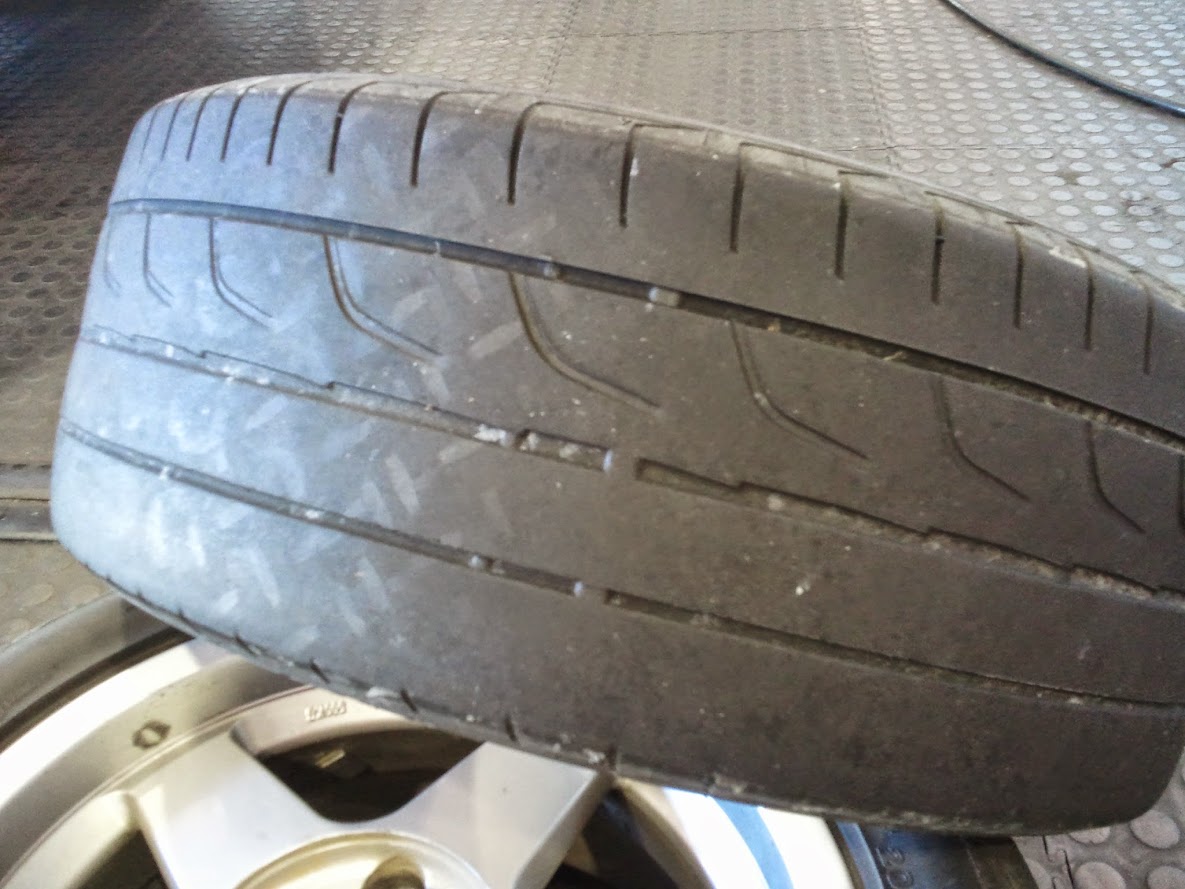
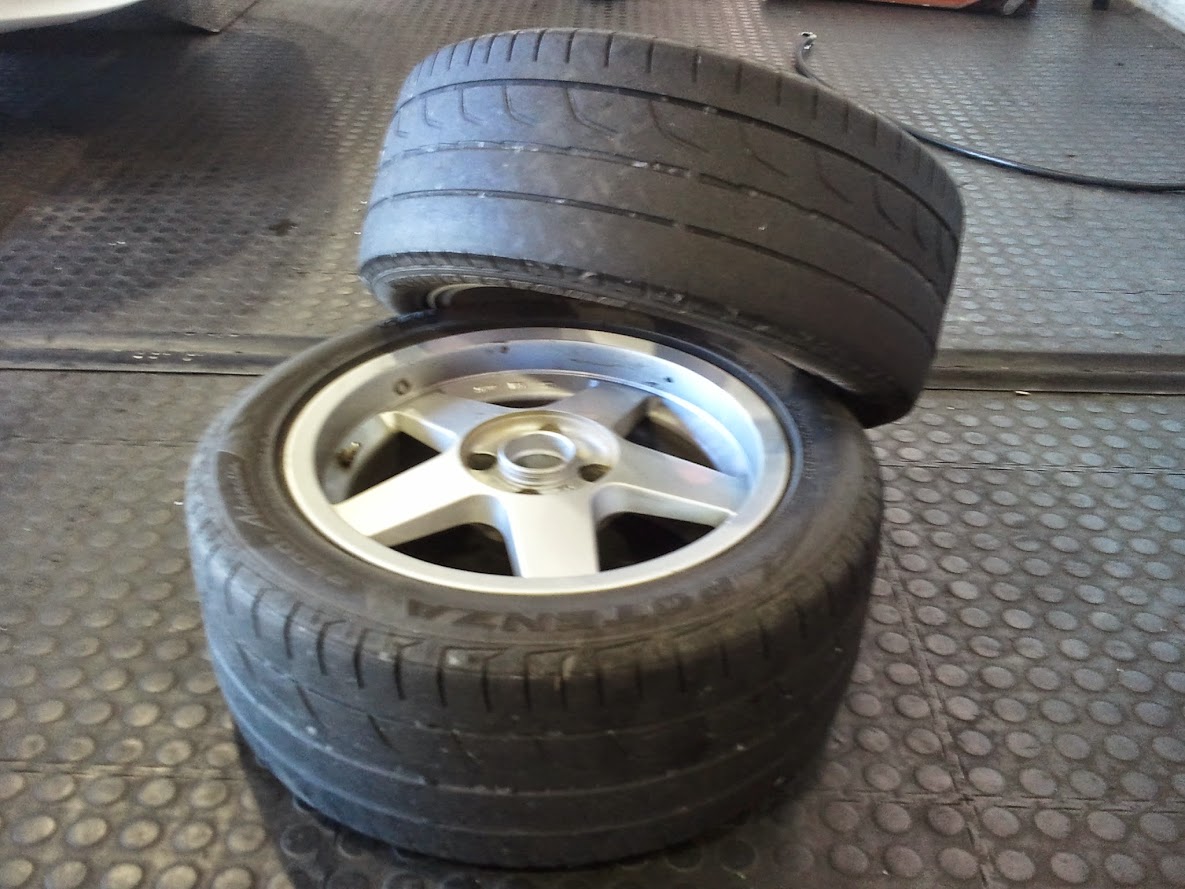
I'm not sure if it was the extra weight over the boot, the softer Bridgestone Potenza compound, or a combination of both, but there was literally nothing left of my two rear tyres. I couldn't believe that we had completed a 2000km trip, coming out on tires that looked like this in the end. But, we had, and now I had to replace them. It was the most expensive part of the trip, by far.